DEATH AND MOURNING
 |
c. 1st Cent. BCE. |
Despite this natural conservatism, both beliefs and practices have changed over the centuries.
- About the second century BCE, the Pharisees introduced the belief in life after death, and the fact that grave goods have been found in tombs of this era seems to link with that belief. The Hebrew Bible is deliberately vague about what happens after death, and uses phrases like gathered to his people59. or sleeping with his fathers.60. While the Jewish authors of the Apocryphal books firmly believe in the afterlife.61.
- In Talmudic times, those who carried the coffin usually did so bare-foot and mourners also refrained from wearing shoes.
- From the second century BCE for about 500 years, it was a common practice around the Jerusalem area to have two burials. About a year after the first burial the bones were gathered up and reburied in small ossuaries.62.
- It was a common practice to have musical instruments accompanying the funeral procession.63
(59.) Gen 29, 8; Num 27, 13, etc. (60.) Deut 31, 16; 2 Samuel 7, 12. (61.) 2 Maccabees 7, 14, & 12, 44. (62.) Pes. 8, 8; Moed Kat. 1, 5; San. 6, 6; Ber.18a; Moed Katan 8a; Goodenough: Jewish Symbols, vol 1, pp.110 ff. & E.J. vol 12, 1503 ff. (63.) Ket. 4, 4; Ket 17a. (64.) Yore De'ah 375,1 & 382, 1.
BEFORE DEATH.
It is the custom for a dying person to make their peace with God by making a confession (vidui). This confession does not require an intermediary like a Rabbi or a Cohen (priest). Standard texts for these can be found in any  Siddur (Daily Prayer Book). If the dying person is unable to speak the words, someone else may do so on his or her behalf. Based upon the Talmudic account 65. of the martyrdom of Rabbi Akiva (2nd cent CE), it is thought to be especially meritorious if one's last words are the first line of the Sh'ma: Hear O Israel, The Lord our God, the Lord is One.66.
Siddur (Daily Prayer Book). If the dying person is unable to speak the words, someone else may do so on his or her behalf. Based upon the Talmudic account 65. of the martyrdom of Rabbi Akiva (2nd cent CE), it is thought to be especially meritorious if one's last words are the first line of the Sh'ma: Hear O Israel, The Lord our God, the Lord is One.66.
(65.) Berachot 61b. (66.) Deut. 6, 4.
AFTER DEATH.
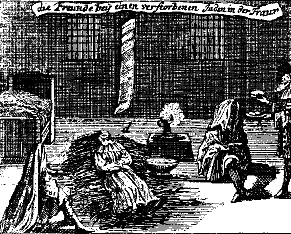 |
After death the eyes are closed and the body laid out. It used to be the custom not to leave the corpse unguarded and watchers were employed to sit with it. The probable reasons for this were respect for the body and to ensure that no rodent or other animal would attack the corpse or perhaps even to protect from body snatchers.
In Talmudic time there grew up a belief in bodily resurrection at the end of days. This together with the need to give due respect to the body, seems to be the reasons why the very orthodox object to autopsies and search for even the smallest fragments of bodies at the site of explosions, in order to bury them. However, it generally agreed 1. that where an autopsy can provide medical knowledge which could prevent someone else dying of the same condition, an autopsy is permitted on the grounds that it is  Pikuach Nefesh.2. (Rabbinic term for saving of life which has priority over other commandments)
Pikuach Nefesh.2. (Rabbinic term for saving of life which has priority over other commandments)
With regard to the donation of body parts, there is a difference of opinion among Rabbis. For many years, corneal transplants have been permitted,3. on the grounds that by giving sight to a blind person might well save that person from accidental death. Today, many Jews no longer believe in bodily resurrection; but hope instead for a continued spiritual existence. Because of this change in belief rather more Jews are prepared to donate organs.
(1.) Rabbis Ezekiel Landau, I Jacobovits & B.M.Ouziel. (2.) Yoma 82a. (3.) Rabbi I.Y.Unterman.
FUNERAL PREPARATIONS.
The body is usually washed before the funeral. This called the Taharah, and is often carried out by a volunteer group in the community known as the Chevrah Kadishah, (the Holy Society). The corpse is usually dressed in simple white burial garments, so as to avoid making a distinction between rich and poor. (See also COFFINS AND FLOWERS.) The coffin, too, is plain for the same reason. Men are usually clothed also in their  Tallit the fringes of which have been made ritually unfit. (Presumably because he is unable to fulfil any longer the mitsvot of which the fringes were the reminder.)
Tallit the fringes of which have been made ritually unfit. (Presumably because he is unable to fulfil any longer the mitsvot of which the fringes were the reminder.)
FUNERAL SERVICE.
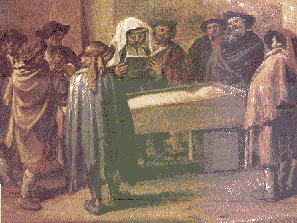 |
Today, coffins are usually closed. |
The Funeral Service takes place in the  Ohel (literally a tent but the name for the chapel or prayer hall). The coffin is placed on a bier. During the service a Hesped, a eulogy, is delivered. During the service prayers and psalms are recited. Among the passages that are said is The Lord has given, the Lord has taken away, Blessed be the name of the Lord.4. This teaches us that we should not only think of our loss, but also give thanks for the life that has ended. That was what the Hesped was for. We fulfil the third part when the mourners say the
Ohel (literally a tent but the name for the chapel or prayer hall). The coffin is placed on a bier. During the service a Hesped, a eulogy, is delivered. During the service prayers and psalms are recited. Among the passages that are said is The Lord has given, the Lord has taken away, Blessed be the name of the Lord.4. This teaches us that we should not only think of our loss, but also give thanks for the life that has ended. That was what the Hesped was for. We fulfil the third part when the mourners say the  Kaddish (the prayer associated with death).
The meaning of this prayer is praise of God. Judaism teaches that although we suffer sadness at parting from loved ones, we should still praise God.
Kaddish (the prayer associated with death).
The meaning of this prayer is praise of God. Judaism teaches that although we suffer sadness at parting from loved ones, we should still praise God.
Other prayers speak of God as the righteous Judge. Such prayers are said to try to help us to accept the loss. At the time of the interment we often say May he/she come to their rest in peace. When the coffin is put in the grave, the people present help to fill in the grave. It is regarded as a mitzvah, a fulfilment of a religious command or duty. It is the last thing that we can do for our loved one. Sometimes a small amount of soil taken from Israel is placed in the grave. Ever since Jacob and Joseph left instructions that they wanted to be buried in the land of their fathers5. it was thought to be a special merit to be buried in the soil of the holy land.6.
(4.) Job 1, 21. (5.) Gen. 49, 29-30. Gen 50, 25. (6.) Ket. 111a.
COFFINS AND FLOWERS.
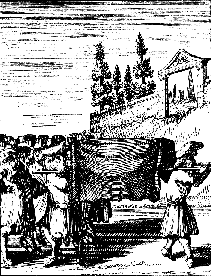 |
Germany, c. 1750. |
Although in Biblical times the dead were often buried wrapped only in woven cloth garments, by Talmudic times coffins were used. Some of the burial procedures became so elaborate that the poor felt shamed when they could not afford to honour their relatives in such a way. In an effort to combat this, Raban Gameliel left instructions that his burial should be simple.7. His example is followed to this day, and it is normal to be buried in a simple plain wooden coffin.
The same principal applied to flowers. It is not usual to have floral tributes at Jewish funerals. It is considered a non-Jewish custom (Chukkat ha-goy). When non-Jewish friends want to buy flowers they are often advised to give the money they would have spent to a charity which the dead person would have supported. Giving to charity in this way was seen to bring honour or reward to the dead.8.
(7.) Moed Katan 27a & b . (8.) Baba Batra 10a.
WOMEN AT FUNERALS.
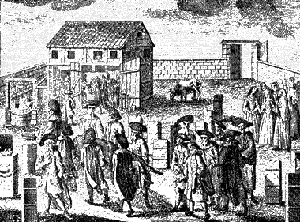 |
Germany, 1748. |
In the second century CE it was usual for women to attend funerals and to sing dirges.9. This custom probably goes back to Biblical times, as Jeremiah says Summon the dirge singers, send for the skilful women to come; let them make haste and raise a wailing over us, that our eyes may run with tears.10. For many centuries women were regarded almost as professional mourners and were asked to attend and they played an important part. In the middle ages the custom began to change. Amongst the Ashkenazim women were no longer expected to attend while the Eastern Sephardim still used them as special mourners. Attitudes continue to vary. The author of the Zohar (13th cent.) disapproved of their attending and Rabbi H.Rabinowicz, who was moderately orthodox stated in 1964: In Anglo-Jewry women are discouraged from attending.11. although he said there was no din (Rabbinic ruling) against them being present.. While in 1864, the Kitsur Shulchan Aruch took it for granted that women attended, and only insisting that men should not mingle with the women either on the way to or from the funeral because of the danger of them being together at that time.12. But it failed to mention what the danger was.
Reform, Liberal and also some orthodox have returned to the old tradition of having women attend funerals. It seems rather heartless to deprive women of being present at the last ceremonies concerned with their loved ones. It seems strange to suggest that women might be less in need of the comfort, which the funeral service can bring.
(9.) Moed Katan 3, 8 & Ber. 20a. (10.) Jer. 9, 16-7. (11.) Guide to Life p. 52. (12.) KSA 198, 10.
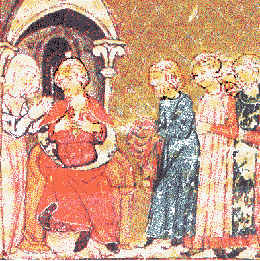 |
14th Cent Spanish Haggadah. |
KERI'AH.
 Keri'ah (tearing) is the tearing of garment by close mourners. This was an ancient way of expressing grief which existed in biblical times. Jacob tore his garments when his sons showed him Joseph's blood-stained coat.13. and King David tore his clothes on hearing of the death of Saul and Jonathan.14. Keri'ah is only required for those who have lost:
Keri'ah (tearing) is the tearing of garment by close mourners. This was an ancient way of expressing grief which existed in biblical times. Jacob tore his garments when his sons showed him Joseph's blood-stained coat.13. and King David tore his clothes on hearing of the death of Saul and Jonathan.14. Keri'ah is only required for those who have lost:
| Father | Mother |
| Brother | Sister |
| Half-Brother | Half-Sister |
| Son | Daughter |
Originally the tearing was done on hearing of the death. However, today, it is more usually done immediately before the funeral service. When the tearing takes place the mourner says a blessing which speaks of God as the true Judge. and thereby accepting their sad situation. For another reason for Keri'ah see FUNERAL PSYCHOLOGY.
Keri'ah was also carried out for other kinds of grief besides death.15. As this is mot a modern way of expressing our grief, it is not the normal practice for Reform or Liberal Jews. Some Orthodox Jews feel that they have fulfilled the requirement by having their tie cut. Originally, those present at a person's death, were required to cut their garments. However, this practice stopped when it was found to discourage people from attending the sick.16.
(13.) Gen. 37, 34. (14.) 2 Samuel 1, 11. (15.) 2 Samuel 15, 22; 2 Samuel, 13, 19. (16.) H. Rabinowicz: Guide to Life, p. 35.
WASHING HANDS.
After the interment all present wash their hands. Many also wash their hands again before entering a house. The suggested reasons for the custom are:
- To signify that one had no responsibility for the death of the person.17.
- Anyone touching a dead body is regarded to be in a state of uncleanliness18. and while in that state was not allowed into the tabernacle.
Just like the spade used for burial, the vessel used for pouring water on the hands is not actually passed on to the next person. This is possibly due to the superstition that one might be passing on death or the contamination of death to someone else.
It is interesting that we can trace historically the introduction of washing of hands. In the ninth century CE Gaon Sar Shalom stated the custom was recent and it was not obligatory. It was still not a requirement in the fourteenth century, but by the sixteenth, it was described as the normal custom and by the nineteenth century it was virtually a required practice.19. In these later sources washing was done after the throwing of grass.
(17.) Deut. 21, 6-7. (18.) Numbers 19, 11. (19.) Schauss: The Lifetime of a Jew p. 292; SA Yoreh De'ah 376, 4; KSA 199, 10.
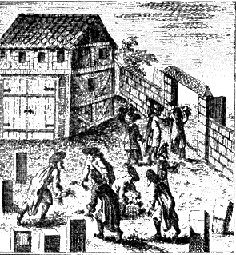 |
Germany, 1748. |
THROWING GRASS.
There is a custom of plucking some grass and throwing it behind one, which is occasionally practised. It is mentioned by Joseph Caro in the 16th cent.20. While throwing the grass, it was usual to say a biblical verse either psalm 72, 16 or Psalm 103, 14, which refer to grass and dust respectively. It has also been explained as a superstitious practice, which was supposed to stop the ghost of the dead person from following them home.21.
(20.) SA Yore De'ah 376, 4. (21.) Schauss: The Lifetime of a Jew, p. 288.
CONSOLING MOURNERS.
Mourners are defined as those with a close family relationship to the deceased. (For list see KERI'AH.) At the end of the funeral it is usual for each person present to say a few words of consolation to each of the mourners. The Talmud states: Our Rabbis taught: Formerly the mourners used to stand still while the people passed by. But there were two families in Jerusalem who contended with one another, each maintaining, �We shall pass first�. So the Rabbis established the rule that the public should remain standing and the mourners pass by. Rammi bar Abba said: R. Jose restored the earlier custom in Sepphoris, that the mourners should stand still and the public pass by.22. Both practices are still in use. If the mourners move then the comforters often stand in two lines, which the mourners pass between. If the mourners are still, then they are often seated.
Standard words of comfort often used are May the Lord comfort you and all who mourn and also I wish you long life but many prefer to say something more personal. The phrase Long life is thought to originate in a passage in Midrash Rabba 23. where it says: When a man loses a son it is usual for people to comfort him and say "May your other son who is left to you live." And if he has no other son they say "We wish you long life."
(22.) San. 19a. (23.) Esther 8, 2.
COHANIM & FUNERALS.
 |
Prague, 1526. Showing the sign of priest's hands. This sign often is used on gravestones of Cohanim. |
The Torah lays down special rules for the descendants of Aaron who conducted the sacrifices in the Tabernacle and later in the Temple. Members of this family were known as Cohanim (the plural of Cohen) which means priest. The Torah states 24. that a Cohen should not make himself unfit for priestly duty by coming into the presence of a dead body except for close relatives. (For list see KERI'AH.) Despite the fact that they are no longer called upon to offer sacrifices, Cohanim are still not permitted to be under the same roof as a corpse, unless it is for one of these relations. Nor should he come within six feet of a grave.25. In order to avoid breaking these laws, Orthodox cemeteries usually have a room with a separate roof specially for descendants of Aaron. There is usually some sound equipment to relay the prayers. It is also a common practice to bury Cohanim by the side of paths so that relatives can visit without being regarded as defiled.
(For more about Cohanim, see PIDYON HABEN
(24.) Lev. 21, 1 ff. (25.) S A Yore De'ah 371, 5.
CREMATION.
All funeral customs described so far on this site have described burials. Orthodox Judaism only practices burial for the following reasons:
- That it is commanded.26.
- That the body should be returned to the earth.27.
- That the corpse should lie in soil to speed up decomposition. This accounts for the Ultra-Orthodox custom of burying bodies wrapped in shrouds with no coffins.
- Because the body should lie and wait for it's resurrection.28.
- It is the only way to give due honour to the body.28.
History however, tells us that in Biblical times cremation was occasionally practised. The most notable occasion was that of King Saul and his sons.29. Other instances are also mentioned 30. and there are other references to burning at death; but these may refer either to the burning of a corpse or to the burning of the possessions of the deceased. There is one Midrash which describes how Isaac asked Abraham to cremate his body and take his ashes back to Sarah in an urn. 31.
It is clear that Jewish funeral customs were often very different from present accepted practice. (See Second burials and Musical instruments) In the last 100 years since modern techniques of cremation have become available, many Jews have left instructions that they should be cremated. Such Jews would answer the five arguments given above by saying:
- Burial was commanded in those days because it was then very difficult to cremate bodies properly.
- The ashes of cremated persons are also usually returned to the earth.
- Cremation, in fact, speeds up the process of returning the body to dust and ashes.
- Many modern Jews do not believe in bodily resurrection.
- Cremation may well give more honour not less to the body than does burial. This is particularly true where there has been clumsy handling of the coffin at burials or incorrect grave digging or when bad weather causes those present to become disturbed, distracted or even ill.
When Jewish cremation takes place the same prayers are said as at a burial. However at a cremation it is possible to have instrumental music which can help to soften the ceremony and ease the grief. The use of music can be viewed as a reintroduction of an ancient Jewish custom. (see Musical instruments)
One emotional problem which tends to prevent Jews from opting for cremation is the memory of the fact that many of the Holocaust victims were forcibly cremated in the death camps.
(26.) Gen 3, 19; Deut. 21, 23 & SA Yore De'ah 362, 1. (27.) Gen 3. 19. (28.) Tykoczinsky: Gesher Ha-Hayim 2 (1947) (29.) 1 Sam. 31, 12-13. (30.) Lev. 20, 14: Lev. 21, 9 and possibly also Amos 6, 10. (31.) L.Ginzberg: Legends of the Jews Vol 1 p. 280 & Midrash Va-Yosha (Jellinek, Beit Ja-Midrash 1, 37.)
SHIV'AH.
After the funeral mourners return to the home of the deceased, and stay there for seven ( Shiv'ah) days. (The seven include the day of the funeral.) Because the mourners do not go out to attend synagogue services, services are held each day in the home. Friends and relatives come to visit. Comforting mourners is considered a mitsvah.32. The visitors also help to make up the minyan for the prayers.
Shiv'ah) days. (The seven include the day of the funeral.) Because the mourners do not go out to attend synagogue services, services are held each day in the home. Friends and relatives come to visit. Comforting mourners is considered a mitsvah.32. The visitors also help to make up the minyan for the prayers.
The Torah mentions that Joseph mourned seven days for his father Jacob;33. but in that case it was before the burial. The Palestinian Talmud attributes the introduction of the Shiv'ah to Moses.34. It seems to have been an established custom by the 1st cent. BCE as Ecclesiasticus (Ben Sirach) states Mourning for the dead lasts seven days.35.
During the seven days the mourners if strictly observant are required (among other things):36.
- Not leave the house.
- To sit on low stools. (formerly it was on upturned bed 37. or on the floor)
- Not to wear leather shoes.
- Not to shave.
- Refrain from sexual intercourse.
- Not to do business or any manual work.
- Not to bathe or anoint themselves except for hygienic reasons.
It is no longer required that they wear sackcloth or put ashes on their heads, as was done in biblical times. Many of these prohibitions are similar to those for Yom Kippur. The reasons for most of them are explained in PSYCHOLOGY OF MOURNING.
A Shiv'ah is interrupted by the Sabbath for that should not be a day of sadness. It is terminated completely when a major festival intervenes. Not everyone observes a full seven days in this way. A fuller account of the laws of mourning can be found in the Shulchan Aruch Yore De'ah 375-403 or in the Kitsur Shulchan Aruch 4, 203 - 220.
Many present day mourners feel that they have a duty to supply refreshments for the people who call during the seven days. However the original Jewish tradition was quite the opposite. Mourners were thought not to be in a fit state to prepare food and the friends and relatives who visited were expected not to call empty handed but to provide food for the mourners. The first meal after the funeral either contained lentils or eggs. The latter being a symbol of new life.
(32.) Avot D' Rabbi Natan 30, 1 (Soncino p. 144.). (33.) Gen 50, 10. (34.) TJ Ket. 1, 1. (35.) Ben Sirach 22, 12. (36.) KSA 4, 208, 1. (37.) Moed Katan 15a & b.
SIGNIFICANCE OF SEVEN.
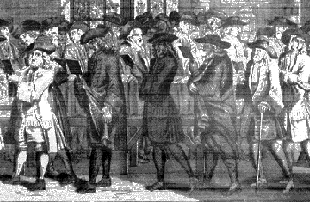 |
a coffin. Amsterdam, 1723. |
The number seven appears prominently in funeral customs. The seven days of Shiv'ah have been explained as having a biblical origin. Sephardi Jews had the custom of walking round the coffin in the prayer hall either seven or three times. While it was a widespread custom to make seven halts in the funeral procession to the cemetery.38. Today, it is more usual to make the seven stops on the way to the grave in the cemetery. The explanation given for the seven is that they correspond to the seven times the word vanity occurs in Ecclesiastes (Kohelet) while Ganzfried adds the seven halts in the Temple, the seven portals of Gehenna and the seven judgements passed on the dead.39. The link with Kohelet is the oldest explanation, but it is weak, as it occurs only five times in the verse quoted in the Talmud, while the rest of the book has many more occurrences. In all probability all the explanations are homiletical. They cover up the fact that seven was a lucky number, and was used to ward off the influence of ghosts and spirits, which were thought to be present at funerals.
(See also THE SEVEN BLESSINGS.)
(38.) Baba Batra 100b. (39.) KSA 4, 198, 12.
THIRTY DAYS.
Talmudic Rabbis said :Three days for weeping and seven for lamenting and thirty [to refrain] from cutting the hair and [donning] pressed clothes.40. These periods do not follow each other but each are counted from the day of the funeral. The thirty day period is known as  Sh'loshim which means thirty. The prohibitions are not quite as strict, and this helps to lighten the burden of the immediate grief. Or looked at another way, the Talmudic saying is describing part of the process of grief, and the practices reflect the changes, which begin to occur within the mourner. (see PSYCHOLOGY OF MOURNING.
Sh'loshim which means thirty. The prohibitions are not quite as strict, and this helps to lighten the burden of the immediate grief. Or looked at another way, the Talmudic saying is describing part of the process of grief, and the practices reflect the changes, which begin to occur within the mourner. (see PSYCHOLOGY OF MOURNING.
Although many of the restrictions of the Shiv'ah still apply to the remaining days of the Sh'loshim, one is allowed to resume ones work, there are less restrictions on the wearing of new clothes, etc. The origin of the thirty day period is probably taken from the mourning periods after the death of Aaron and Moses which each lasted thirty days.41.
(40.) Moed Katan 27b. (41.) Num 20, 29 & Deut. 34, 8, respectively.
IN A HOUSE OF MOURNING.
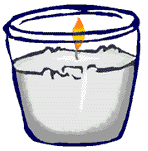
Throughout the seven days of the Shiv'ah a light is kept burning. The light may be symbolic of the soul of the departed. The soul of man is the light of the Lord.42. We use a light to remember someone who brightened our lives when we light a Yahrzeit candle. We also use light to symbolise God's presence with Ner Tamid (the Perpetual light) before the Ark in the Synagogue. Amid the sadness and gloom of mourning, light is a symbol of hope and of comfort.
There was an old custom of pouring away any bowls of water after a death.43. The reason for this is not clear and it was probably a superstition. It has been suggested:
- The angel of death washes his sword after a death and so the water may be harmful.
- It enables the soul of a dead person to leave the house, because souls can not travel over water.
- It is a way of announcing a death to passers by or to Cohanim who might otherwise enter.
- Water is a reflective surface like a mirror. All the reasons for COVERING MIRRORS. would therefore apply to water also.
(42.) Prov. 20, 27. (43.) SA Yore De'ah 339, 5.
NOT SHAVING.
The current practice among Orthodox Jews is not to shave during either the 7 or 30 day periods. This custom dates back to biblical times, where it states you shall not cut yourselves or make any baldness on your foreheads for the dead.44. The reason given there implied that this was a local pagan practice. It was certainly a Moabite practice.45. In two of the later books of the Bible we read:
- Job on hearing of the death of all his children rent his robe and shaved his head.46.
- Ezra showed his grief at hearing that a group of priests refused to separate from their pagan wives rent his garments and his mantle and pulled hair from his head and beard, and sat appalled.47. (It does not state whether he sat on the ground.)
These verses show that the law was not observed, and even someone as pious as Job did not follow it. By the time of the Talmud the law was back but observed with certain exceptions.48. Today it is only obeyed by the most observant of Jews.
(44.) Deut. 14 1. (45.) Jeremiah 48, 37. (46.) Job 1, 20. (47.) Ezra 9, 3. (48.) Moed Katan 14a. see also S A Yore De'ah 390, 1.
COVERING MIRRORS.
It is now common practice for people to cover mirrors in a house of mourning or else turn them to face the wall. It is however not required and appears to be just a folk custom that originated outside of Judaism. Rabbi S Freehof listed 49. the following explanations for the custom:
- In order not to see in the mirrors the evil spirits that are present in houses of mourning.50.
- The departing spirit of the deceased may be caught in the mirror. 51.
- As we no longer carry out the old custom of overturning beds with mourners sleeping on the floor 52., mirrors are turned to the wall instead.53.
- If after a death, a person sees his image reflected in a mirror he will himself shortly die. This based on the idea that a reflection is the insubstantial soul of the person, which may be carried away with that of the recently deceased.54.
- To stop people being concerned with vanity rather than with mourning. 55.
- To prevent the mourner seeing his sad unshaven face which would make him more depressed.
- It is forbidden to pray in front of mirrors.55.
- There is a folk belief that the reflections of spirits are not visible in mirrors.56. As various spirits are present in a house of mourning, and the mirrors would therefore reveal them. 57.
- The covering of glass mirrors may be linked with the custom of drawing the curtains to cover windows in a house of mourning. This custom is still common in parts of Britain. This in turn has been linked either with the closing of the eyes after death or as a discrete way of announcing a death. 57.
Most of these reasons are far from convincing and many rely on superstition. And as there is no requirement in Jewish law for us to do this, it would therefore seem more religious not to cover mirrors than to do so.
(See Also pouring away water IN A HOUSE OF MOURNING. )
(49.) Reform Responsa p. 179f. (50.) Schwartz V'Yelaket Yosef vol xiv, No. 110. (51.) Hirshowitz: Ozar Kol Minhagey Yeshurun p. 303. (52.) Moed Katan 15a & b; S.A. Yore De'ah 387, 1, & 2. (53.) Attributed to Moses Sofer by J. Schwartz. (54.) Encyclopedia of Superstitions p. 174. (55.) Jewish Book of Why, p. 64 (56.) eg. Bram Stoker: Dracula. (57.) Suggestion of Web Master.
YEAR OF MOURNING.
For the remainder of the year it is the custom for a parent to attend daily services and to say the Kaddish for them. By saying Kaddish the congregation has to respond praising the Divinity. Pre sixteenth century folklore tells us 58. that a son or daughter doing this for a parent will bring merit upon the parent and cause their soul to leave Gehenna before the usual year is up. The period for saying Kaddish was shortened to eleven months because if one did it for a full year it might imply that one thought one's parent to be particularly bad.59.
At the end of the year a  matsevah (tombstone) is put on the grave. Stone masons recommend that relatives wait at least six months before erecting a stone as the ground needs at least that time to settle. If done too soon, the stone may tilt or even crack. The Sephardim usually have horizontal stones, so that nobody is higher than anyone else in death. While many Ashkenazi cemeteries have a height limit for the same reason.
matsevah (tombstone) is put on the grave. Stone masons recommend that relatives wait at least six months before erecting a stone as the ground needs at least that time to settle. If done too soon, the stone may tilt or even crack. The Sephardim usually have horizontal stones, so that nobody is higher than anyone else in death. While many Ashkenazi cemeteries have a height limit for the same reason.
(58.) M. Gaster: Ma'aseh Book No. 146, p.286. (59.) Isserles: SA Yore De'ah 376, 4.
THE TOMBSTONE.
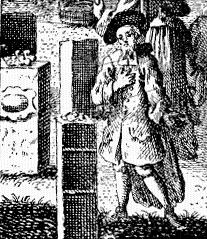 |
Germany, 1748. Detail of another illustration |
In Britain, it is the custom to have a short service of consecration around the stone, which often also serves to mark the end of the year of mourning. In many other parts of the world the stone is erected without a special service.
When people visit a grave it is a common practice to place a small pebble on the grave to show that one has visited. The origin of this custom may possibly go back to Biblical times, when graves were often marked with a pile of stones.60. After some time, the elements made the stones to disperse, and it was necessary for the pile to be built up again. So in a way, by placing a pebble on the grave the visitor is helping to preserve the memory of the dead person.
WARNING Stone masons try to discourage people from placing pebbles on white stones as this often causes the gravestone to be discoloured.
(60.) 2 Samuel 18, 17.
PSYCHOLOGY OF MOURNING.
When someone close to us dies we are often filled with many mixed emotions. Sometimes it is anger at the loss and the pain caused to us. Sometimes it a feeling of powerlessness to do anything about it. And sometimes it a feeling of guilt that we might have been able to do more to look after the dead person or made his or her life more happy. To a certain extent Jewish rituals seem designed to ameliorate some of these problems.
The number of ritual acts and the very structured periods of mourning have the effect of mapping out a course for the mourner. A passage from the Midrash states: In the ordinary course of things, grief goes on diminishing over seven days. It is strongest on the first day and grows weaker and weaker over a period of twelve months.61. The gradual lightening of the mourning from the deep grief at the funeral and the Shiv'ah, through the 30 days and then the year of lesser mourning ending with the stone-setting, seem to parallel the mood of many mourners. It gives us a structured path to follow, which is intended to help us come out of the initial shock and disorientation caused by the death.
The guilt feelings are assuaged by some of the rituals, which are thinly disguised self-punishment. In biblical times the wearing of sackcloth and ashes was intended to be deliberately uncomfortable. Keri'ah with its destruction of a garment, the sitting on low uncomfortable seats, and many of the other customs help to achieve this. One of the clearest indications of self-punishment is shown in the Kitsur Shulchan Aruch, 62. where it tells us that mourners should not wear leather shoes and should stay at home during the seven days of Shiv'ah. It goes on to say that if one has to go out for some reason, then we can wear leather shoes as long as we place a little earth inside them. It is noticeable that many of the actions forbidden to mourners are things which pamper the body, like washing in warm water, wearing freshly ironed clothes or anointing oneself.63. In some instances it is said that it is forbidden to do so for pleasure.64.
(61.) Esther Rabba 8, 2. (62.) ch. 204, 1. (63.) KSA 4, 209, 1 & 211, 7. (64.) KSA 4, 209, 3 & 211, 8.
YAHRZEIT.

A Yahrzeit is the anniversary of the death of a parent. The word is Yiddish and means a year's time. Although was originally introduced as a day to say Kaddish for a mother or father, today, many also keep the Yahrzeits of other close relatives. The day is observed by the lighting of a memorial light and by keeping it burning for the full Jewish day from sunset to sunset. It is usual to attend Synagogue on that day for the Kaddish, or at least attend some place where there will be a Minyan for Kaddish. In a community where there is no weekday minyan, it is usual to attend on a service on the Shabbat before the date. It is usual to call up those with Yahrzeits by giving them an Aliyah.
The Talmud mentions people who took an oath not to eat meat or drink wine on the anniversary of their father's death.65. These appear to have been special cases rather than a widespread current practice. Probably custom of observing a Yahrzeit was introduced after the Kaddish became associated with death. As the name suggests, it was first introduced by the Ashkenazim. One of the earliest mentions is by the Maharil (Jacob Moellin) in the early 15th century. But the burning of a memorial candle was not widely practised until the 17th century, and may well have been originally a Christian practice.66.
(65.) Nedarim 12a; Sh'vuot 20a. (66.) Schauss:The Lifetime of a Jew, p. 298.
| FOR FULL ALPHABETICAL INDEX |